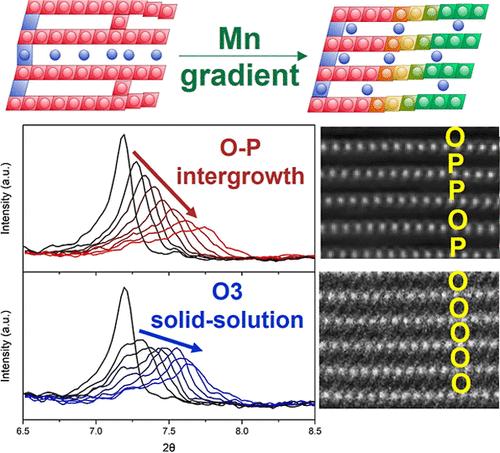高压钠层氧化阴极表面电化学-机械相互作用诱导的固溶相变
IF 16
1区 材料科学
Q1 CHEMISTRY, MULTIDISCIPLINARY
引用次数: 0
摘要
钠层氧化物(SLO)阴极的相变行为对其在高压下的电化学性能起着重要作用。具体来说,slo经历了从P到OP互生相的相变,其中Na- O层缺乏,导致Na提取/插入动力学缓慢,应变形成严重,与电解质的反应活性高。除了通常使用的相工程策略,如体掺杂,我们在这里证明了mn梯度面层可以显着调整体相从OP互生到O3固溶转变,这是由原位XRD和Cryo-STEM分析证明的。在高压下,富mn表面与本体相比具有异步Na萃取特性,由于产生的应力不能很好地释放,抑制了OP共生相的成核和生长,同时促进了无应力O3固溶相的形成。得益于O3固溶相变行为,富mn表面的SLO在高达4.3 V的高压下,在能量密度、速率性能、能量转换效率和循环稳定性等方面都有显著提高。本文章由计算机程序翻译,如有差异,请以英文原文为准。

Solid-Solution Phase Transition Induced by Surface Electrochemico–Mechanical Interactions for High-Voltage Sodium-Layered Oxide Cathodes
The phase transition behaviors of sodium-layered oxide (SLO) cathodes play an important role in their electrochemical performances at high voltages. Specifically, SLOs experience a phase transition from the P to OP intergrowth phase with Na-deficient O layers, leading to sluggish Na extraction/insertion kinetics, severe strain formation, and high reactive activity with electrolytes. In addition to the normally used phase engineering strategies such as bulk doping, we demonstrate here that a Mn-gradient surface layer can significantly tune the bulk phase transition from the OP intergrowth to O3 solid-solution transition, evidenced by in situ XRD and Cryo-STEM analyses. The Mn-rich surface has asynchronous Na extraction properties compared to the bulk at high voltages, suppressing the nucleation and growth of the OP intergrowth phase as the generated stress cannot be well released while facilitating the formation of a stressless O3 solid-solution phase. Benefiting from the O3 solid-solution phase change behaviors, the SLO with the Mn-rich surface shows much improved electrochemical performances at high voltages up to 4.3 V in terms of energy density, rate performance, energy conversion efficiency, and cycling stability.
求助全文
通过发布文献求助,成功后即可免费获取论文全文。
去求助
来源期刊

ACS Nano
工程技术-材料科学:综合
CiteScore
26.00
自引率
4.10%
发文量
1627
审稿时长
1.7 months
期刊介绍:
ACS Nano, published monthly, serves as an international forum for comprehensive articles on nanoscience and nanotechnology research at the intersections of chemistry, biology, materials science, physics, and engineering. The journal fosters communication among scientists in these communities, facilitating collaboration, new research opportunities, and advancements through discoveries. ACS Nano covers synthesis, assembly, characterization, theory, and simulation of nanostructures, nanobiotechnology, nanofabrication, methods and tools for nanoscience and nanotechnology, and self- and directed-assembly. Alongside original research articles, it offers thorough reviews, perspectives on cutting-edge research, and discussions envisioning the future of nanoscience and nanotechnology.
 求助内容:
求助内容: 应助结果提醒方式:
应助结果提醒方式:


